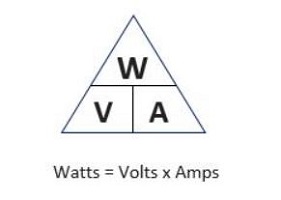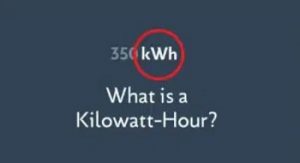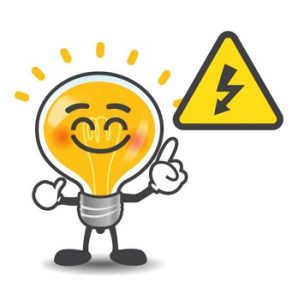Watts Up? One of the most frequently-ask-questions we get is “what size of a generator do I need”?
We usually spend the first hour with our customers to assess what are their reasons to buy a generator, i.e. is it for an occasional power outage, is it for a job-site, or is it for a camping trip?
Next, we will work on what devices or appliances they want to power. Then we calculate the total wattage they need for their portable generator.
What are Volts, Amps and Watts?

As you already know, watt is the most important measure of electrical production and usage in your home environment.
Watts is equal to volts multiplied by amps (W = V x A).
Voltage is the amount of force pushing electricity through a circuit. An Amp (Ampere) is a measure of how much electricity is going through a circuit. Multiplying the Voltage by the Amperage is the electrical system Power, which is measured in Watts.
For some, an easy-to-understand analogy is using water. So, think of voltage is equivalent to water pressure, the ampere current is equivalent to flow rate, and wattage is equivalent to the capacity of the system.
The standard outlets in our houses here in United States are 120 volt variety. If you have a space heater that draws 12.5 amp, then its wattage is 1500 watts. W = V x A = 120 V x 12.5 A = 1500 W.
Another example of a 60-watt light bulb. It draws 0.5 Amps using 120 Volts. W = 120 V x 0.5 A = 60 W.
What is a Kilowatt Hour?
Here in United States, electric utilities typically charge by the kilowatt hour, kWh. For instance, an electric bill can range from $0.10/kWh to $0.25/kWh, depending on time of day.

A kilowatt hour is a measure of the quantity of electricity consumed. A kilowatt is 1000 watts.
If you have an appliance that uses 1000 watts while running, you could run that appliance for 1 hour with a kilowatt hour (KWH) of electricity.
A kilowatt hour is a measure of the quantity of electricity consumed. A kilowatt is 1000 watts. If you have an appliance that uses 1000 watts while running, you could run that appliance for 1 hour with a kilowatt hour (KWH) of electricity.
If you switched on a 100-watt light bulb, it would take 10 hours for that bulb to use 1 kilowatt hour (100 watts X 10 hours = 1 kilowatt hour).
How many watts do you need to power the essential electrical items?
In sizing a home emergency generator, you will want to first decide what appliances, devices, lights, etc., you really want to run at the same time.
Then you gather the running watts to keep your selected items running.
Two fundamental watt numbers you want to gather from each device: starting-watt and running-watt.

Starting watts are the initial, the first 2-3 seconds, needed to start a motor-driven appliance such as a refrigerator. You are correct that you don’t need to factor in starting-watts for a non-motor item such as a 60-watt light-bulb.
Running watts are the continuous watts to keep your device operating. For example, a refrigerator might take 750 running-watt, it would take 2200 starting-watt.
After you add up the running watts for all selected devices, you have the total wattage needed. It is a good idea to give yourself some 10%-20% cushion. So, if the essential devices will consume 3000 running watts, you want to shop for a 3300-watt to 3600 running-watt generator.
Below we show some typical consumption figures. You can use these to estimate your generation needs or you can look for the actual wattage consumption on your key appliances (on the label or in the owner’s manual).
Table of running watts by household appliances and electronic devices
| Appliance | Estimated Running Watts |
| Blender | 300-1000 W |
| Coffee Maker | 600-1000 W |
| Microwave | 1000-1500 W |
| Space Heater | 750-1500 W |
| Refrigerator* | 500-800 W |
| Freezer* | 500-700 W |
| Washing Machine* | 500-1000 W |
| Whole home heater fan* | 750-1200 W |
| TV | 50-250 W |
| Well Pump or Sump Pump* | 750-1050 W |
| Laptop Computer | 20-75 W |
| Wi-Fi Router | 6-20 W |
| Inkjet Printer | 15-75 W |
| Cell Phone Charger | 10-20 W |
| Light Bulbs | 13-150 W each |
| Garage Door Opener* | 550-725 W |
Note: * Motor-driven appliances will require a two to three times higher starting-watts.
As you can see, there are big variation based on individual appliances.
Note: You have probably noted that some of your built-in appliances, like an electric range, cannot be unplugged. So, you may want to have an alternate method to cook food when your electric cooktop is unavailable.
Depending on your home site or situation, your choice may vary. However, if you can boil water, you can make coffee or a simple warm meal, right?
Tip: You can plan to use an outdoor grill or a camping stove outside.
Tip: If you are planning to install a full-backup generator, you can install a transfer switch near your circuit breaker. So when there’s a blackout, it will automatically switch your power source to your generator. In this case, you will likely want a 10,000 watt generator for your whole house power need.
w

Summary
Generators are sized by the watts of output power that they produce. Every appliance, lightbulb, and heater you turn on consumes those watts.
Your goal is to balance the watts produced with the watts you absolutely need to consume. Refer to our table on the watts consumed by typical household devices . Suffice it to say, the largest consumers tend to be devices like refrigerators, heaters, and AC.
